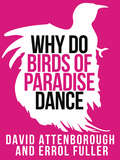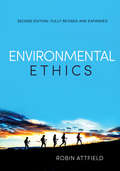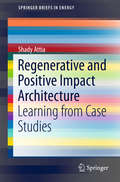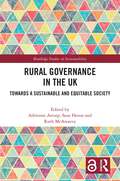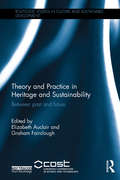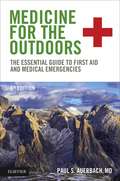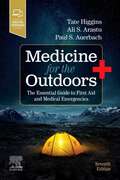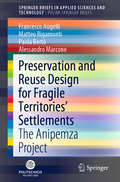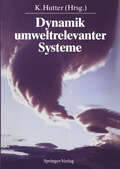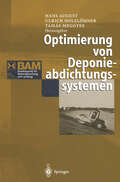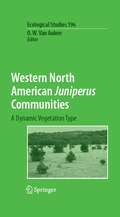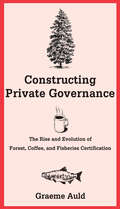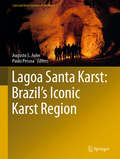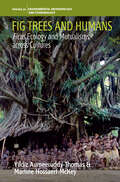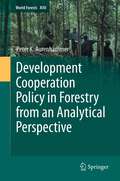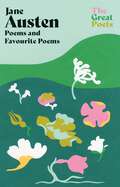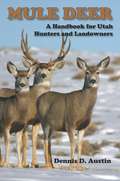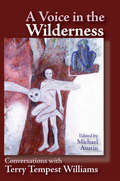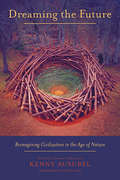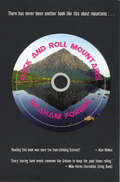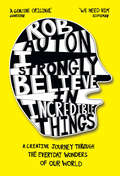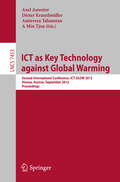- Table View
- List View
David Attenborough’s Why Do Birds of Paradise Dance (Collins Shorts #7)
by Sir David Attenborough FullerCollins Shorts – insight in an instant.
Environmental Ethics: An Overview for the Twenty-First Century (Very Short Introductions Ser.)
by Robin AttfieldIn this clear, concise, comprehensively revised and up-to-date introduction to environmental ethics, Robin Attfield guides the student through the key issues and debates in this field in ways that will also be of interest to a wide range of scholars and researchers. The book introduces environmental problems and environmental ethics and surveys theories of the sources of the problems. Attfield also puts forward his own original contribution to the debates, advocating biocentric consequentialism among theories of normative ethics and defending objectivism in meta-ethics. The possibilities of ethical consumerism and investment are discussed, and the nature and basis of responsibilities for future generations in such areas as sustainable development are given detailed consideration. Attfield adopts an inclusive, cosmopolitan perspective in discussions of global ethics and citizenship, and illustrates his argument with a discussion of global warming, mitigation, adaptation and global justice. The revised edition features a new chapter on climate change, new treatments of animal issues, ecofeminism, environmental aesthetics, invasion biology and virtue ethics, and new applications of the precautionary principle to fisheries, genetic engineering and synthetic biology. The glossary and bibliography have been updated to assist understanding of these themes. The text uses a range of devices to aid understanding, such as summaries of key issues, and guides to further reading and relevant websites. It has been written particularly with a view to the needs of students taking courses in environmental ethics, and will be of interest to students and scholars of philosophy, ethics, geography, religion and environmental studies.
Regenerative and Positive Impact Architecture: Learning from Case Studies (SpringerBriefs in Energy)
by Shady AttiaThis book is a guide to energy efficiency and environmental impact assessment in high-performance buildings projects. It compares four state-of-the-art buildings to examine the steps needed for a transition from negative impact reduction architecture to positive impact regenerative architecture, utilizing life cycle analysis. The book provides a solid grounding in the areas of energy-efficient building and building materials life-cycle assessment, discussing carbon efficiency within a wider context that includes its technical, socio-cultural and environmental dimensions and covers the key areas for green buildings performance (operational and embodied energy). The analysis and comparison of four case studies of state-of-art modern building projects in Europe and North America serve as inspiring examples for architects and building professionals in the fields of high performance buildings, ecological materials and carbon efficiency.
Rural Governance in the UK: Towards a Sustainable and Equitable Society (Routledge Studies in Sustainability)
by Adrienne Attorp Sean Heron Ruth McAreaveyThis book provides a multidisciplinary analysis of rural society in a post-Brexit UK by examining the emergence of new environmental and rural policies and the implications of this transition for rural communities. Through the Common Agricultural Policy, Common Fisheries Policy, the Birds and Habitats Directives, the Water Framework Directive and a myriad of other legislations and institutions, the EU has had a deciding role in how the UK’s rural environment is governed. Disentangling this policy legacy is a complex process and offers both opportunities and challenges for policy makers, institutions, organisations and stakeholders across the UK as they strive to create appropriate new governance structures. With the Agriculture Bill, the 25-Year Environment Plan and the founding of the Office of Environmental Protection, the UK government has provided at least a degree of clarity on the future direction of environmental governance, but much remains uncertain, not least how this is engaged with by different stakeholders. While Brexit is the lens through which rural policy and sustainability are interrogated, this collection demonstrates the underpinning features of rural policy and society, identifying opportunities for addressing deep-seated policy weaknesses thereby creating a more sustainable and equitable rural society. This book brings together academics, established and early career, to discuss the impact of Brexit on rural environmental governance and on the wider sustainability of rural society, relating to three overall themes: rural governance, sustainable land use, and sustainable rural communities. In doing so, it considers sectors beyond agriculture, paying attention to social relations, community infrastructure, the environment, rural development and broader issues of land use. This book will be of interest to students and scholars of rural development, rural entrepreneurship, rural digital inclusion, environmental policy, sustainable development, land use, agrarian studies and environmental geography.
Theory and Practice in Heritage and Sustainability: Between past and future (Routledge Studies in Culture and Sustainable Development)
by Elizabeth Auclair Graham FaircloughThis book explores cultural sustainability and its relationships to heritage from a wide interdisciplinary perspective. By examining the interactions between people and communities in the places where they live it exemplifies the diverse ways in which a people-centred heritage builds identities and supports individual and collective memories. It encourages a view of heritage as a process that contributes through cultural sustainability to human well-being and socially- and culturally-sensitive policy. With theoretically-informed case studies from leading researchers, the book addresses both concepts and practice, in a range of places and contexts including landscape, townscape, museums, industrial sites, every day heritage, ‘ordinary’ places and the local scene, and even UNESCO-designated sites. The contributors, most of whom, like the editors, were members of the COST Action ‘Investigating Cultural Sustainability’, demonstrate in a cohesive way how the cultural values that people attach to place are enmeshed with issues of memory, identity and aspiration and how they therefore stand at the centre of sustainability discourse and practice. The cases are drawn from many parts of Europe, but notably from the Baltic, and central and south-eastern Europe, regions with distinctive recent histories and cultural approaches and heritage discourses that offer less well-known but transferable insights. They all illustrate the contribution that dealing with the inheritance of the past can make to a full cultural engagement with sustainable development. The book provides an introductory framework to guide readers, and a concluding section that draws on the case studies to emphasise their transferability and specificity, and to outline the potential contribution of the examples to future research, practice and policy in cultural sustainability. This is a unique offering for postgraduate students, researchers and professionals interested in heritage management, governance and community participation and cultural sustainability.
Medicine for the Outdoors E-Book: The Essential Guide to First Aid and Medical Emergencies (Lyons Press Ser.)
by Paul S. AuerbachSince 1986, Medicine for the Outdoors has been hailed as the definitive take-along manual on the subject. Packed with step-by-step instructions and how-to explanations, this updated edition tells you the best way to respond to just about any medical problem. Logically organized, simple-to-understand enhanced illustrations and an increased focus on new topics mean this medical reference book may literally save your life. Whether you’re venturing into mountains, deserts, forests, or out to sea, it belongs in your pack! Examine the most diverse and comprehensive coverage of medical conditions related to the outdoors.Be guided through logical and complete explanations of every topic.Enhance your understanding with descriptive material including numerous drawings and instructions.Research recommendations for injury and illness prevention.Locate answers quickly with a helpful comprehensive index.Clearly visualize how to perform specific treatments, such as the use of a SAM® splint, with an increased number of helpful illustrations. Stay abreast of the latest in emergency medicine care, including new antibiotics, medicines, products to control bleeding, and today's most common infectious disease threats.Enhance your understanding of Lyme disease; water disinfection; emerging diseases (including West Nile Virus); and how to seek safety and act during natural disasters.Take advantage of Dr. Auerbach’s expert guidance with revised recommendations on high-altitude problems, drowning, airways management, toxic plants, and snake bites.Access new appendices covering AIDS/HIV transmission, expanded treatment instructions, global conflict guidelines (including terrorism), and canine medicine. Consult this title on your favorite e-reader.
Medicine for the Outdoors E-Book: The Essential Guide to First Aid and Medical Emergencies
by Paul S. Auerbach Tate Higgins Ali S. ArastuFor nearly 40 years, Medicine for the Outdoors: The Essential Guide to First Aid and Medical Emergencies has been the take-along manual of choice for anyone venturing into the mountains, forest, desert, or on water. This essential guide provides highly illustrated, easy-to-follow guidance on immediate stabilization and treatment of persons with virtually any possible medical problem—designed for on-the-spot use when higher-level medical care is not accessible. Written by experts in outdoor medicine, this updated edition helps you manage any situation until medical personnel can take over. Covers key information on a wide range of disorders related to specific environments, including natural disasters, high-altitude problems, water-related incidents, heat- and cold-related illnesses, and wildland fires. Provides easy-to-understand recommendations for dealing with animal attacks, venomous wildlife, wild plant and mushroom poisoning, minor and major medical problems, infectious diseases, water disinfection, and severe bleeding. Discusses key topics, including antibiotics, medicines, opioid overdose treatment, wound closure techniques, severe bleeding, spinal assessment and immobilization, tourniquets, the use of a Gamow bag for severe altitude illness, splinting, dental emergencies, disaster preparedness, global conflict guidelines, canine medicine, today’s infectious disease threats, and much more. Includes up-to-date guidelines, even more helpful illustrations and diagrams, and a new chapter: Patient Assessment: A Structured Approach to Emergencies in the Outdoors. Includes advanced topics valuable to physicians and expedition medical staff at all levels of training and experience.
Preservation and Reuse Design for Fragile Territories’ Settlements: The Anipemza Project (SpringerBriefs in Applied Sciences and Technology)
by Francesco Augelli Matteo Rigamonti Paola Bertò Alessandro MarconeThis book reports on an architectural conservation and reuse project in Anipemza, an Armenian Soviet-era village on the Turkish border, just a few steps away from the important Yererouyk archaeological site. Based on current tourist trends, the book suggests the development of a social system and micro-economic reactivation model to endorse the territory’s numerous cultural resources and preserve the memory of the village that housed the genocide orphanages and the many other stories associated with the village. Further, the development of sustainable tourism will lead to an improved relationship between locals and visitors. Examining the development of a system of strategies able to cope with the existing social, economic and hygiene problems as well as the architectural preservation aims, the book provides valuable guidelines for the local community.
Dynamik umweltrelevanter Systeme
by E. Augstein H. Blatter B. Diekmann H. Fleer F. Gassmann H. Grassl G. Gross K. Herterich K. Hutter W. Klug G. Manier A. Neftel A. Ohmura C. D. Schönwiese F. H. Schwarzenbach M. M. TilzerOptimierung von Deponieabdichtungssystemen
by Hans August Ulrich Holzlöhner Tamas MeggyesDeponieabdichtungssysteme sollen ihre Funktionsfähigkeit über einen weitaus längeren Zeitraum als konventionelle Bauwerke erhalten. Bei Basisabdichtungen kommt erschwerend hinzu, daß sie praktisch nicht zu reparieren sind, keiner Wartung unterzogen werden können und Schadensfälle, d. h. Grundwasserkontaminationen erst mit großer zeitlicher Verzögerung registriert werden können. Daher ist die Optimierung von Deponieabdichtungen besonders im Hinblick auf das Langzeitverhalten der zum Einsatz kommenden Baumaterialien von großem Interesse. Neueste Erkenntnisse erlauben einen aktuellen Einblick in die Eigenschaften von Materialien und deren Langzeitverhalten, vor allem in ihrer Funktion zur Erfüllung des Vorsorgeprinzips für Deponien als Bauwerke mit hoher sicherheitstechnischer Relevanz.
Western North American Juniperus Communities: A Dynamic Vegetation Type (Ecological Studies #196)
by Oscar Van AukenIn North America, Juniperus woodlands occupy approximately 55 million hectares, an area larger than the state of Texas. This title addresses various aspects of the biology, ecology, and management of Juniperus woodlands and savannas, synthesizing past and current research findings as well as proposed research. The book provides ecologists, land managers, and foresters with a solid foundation in Juniperus ecosystems, enabling them to manage the communities for maximum sustained productivity and diversity.
Constructing Private Governance: The Rise and Evolution of Forest, Coffee, and Fisheries Certification (Yale Agrarian Studies Ser.)
by Graeme AuldRecent decades have witnessed the rise of social and environmental certification programs that are intended to promote responsible business practices. Consumers now encounter organic or fair-trade labels on a variety of products, implying such desirable benefits as improved environmental conditions or more equitable market transactions. But what do we know about the origins and development of the organizations behind these labels? This book examines forest, coffee, and fishery certification programs to reveal how the early decisions of programs on governance and standards affect the path along which individual programs evolve and the variety and number of programs across sectors.
Lagoa Santa Karst: Brazil's Iconic Karst Region (Cave and Karst Systems of the World)
by Augusto S. Auler Paulo PessoaThis book discusses the Lagoa Santa Karst, which has been internationally known since the pioneering studies of the Danish naturalist Peter Lund in the early 1800s. It covers the speleogenesis, geology, vegetation, fauna, hydrogeology, geomorphology, and anthropogenic use of the Lagoa Santa Karst and is the first English-language book on this major karst area. The area, which has been at the heart of the debate on the origin and age of human colonization in the Americas, is characterized by a classical and scenic karst landscape with limestone cliffs, karst lakes and karst plains, in addition to numerous solution dolines. More than 1,000 caves have been documented in the area, many with significant archeological and paleontological value. Despite its great importance, the Lagoa Santa Karst faces severe environmental threats due to limestone mining and the expansion of the metropolis of Belo Horizonte and its surrounding towns. The growing recognition of the area’s remarkable significance has led to increasing concern, and a number of protected areas have now been established, improving the conservation status of this landmark karst area.
Fig Trees and Humans: Ficus Ecology and Mutualisms across Cultures (Environmental Anthropology and Ethnobiology #32)
by Yildiz Aumeeruddy-Thomas Martine Hossaert-McKeyHumans and figs form hybrid communities within the context of anthropogenic landscapes, supported by biocultural mutualisms driven by traits of Ficus species and people’s imagination and practices, and where humans also positively influence Ficus species ecology. Fig Trees and Humans examines the interactions between the biology and ecology of the genus Ficus and how humans use and think of Ficus species across the tropics and in the Mediterranean region. It demonstrates a high level of convergence of material and symbolic uses of human-fig interactions that affect various aspects of human culture, as well as the ecology of wild or cultivated Ficus species.
Fig Trees and Humans: Ficus Ecology and Mutualisms across Cultures (Environmental Anthropology and Ethnobiology #32)
by Yildiz Aumeeruddy-Thomas Martine Hossaert-McKeyHumans and figs form hybrid communities within the context of anthropogenic landscapes, supported by biocultural mutualisms driven by traits of Ficus species and people’s imagination and practices, and where humans also positively influence Ficus species ecology. Fig Trees and Humans examines the interactions between the biology and ecology of the genus Ficus and how humans use and think of Ficus species across the tropics and in the Mediterranean region. It demonstrates a high level of convergence of material and symbolic uses of human-fig interactions that affect various aspects of human culture, as well as the ecology of wild or cultivated Ficus species.
Fig Trees and Humans: Ficus Ecology and Mutualisms across Cultures (Environmental Anthropology and Ethnobiology #32)
by Yildiz Aumeeruddy-Thomas Martine Hossaert-McKeyHumans and figs form hybrid communities within the context of anthropogenic landscapes, supported by biocultural mutualisms driven by traits of Ficus species and people’s imagination and practices, and where humans also positively influence Ficus species ecology. Fig Trees and Humans examines the interactions between the biology and ecology of the genus Ficus and how humans use and think of Ficus species across the tropics and in the Mediterranean region. It demonstrates a high level of convergence of material and symbolic uses of human-fig interactions that affect various aspects of human culture, as well as the ecology of wild or cultivated Ficus species.
Development Cooperation Policy in Forestry from an Analytical Perspective (World Forests #13)
by Peter AurenhammerAny reader eager to gain a comprehensive insight into forest development policy, praxis and reality shouldn’t miss this excellent publication. Hard to find a comparable reading where the author is digging as deep into Forest Development Policy. The author discovered numerous highly relevant theories as well as inspiring cases about forests and people from around the world, focusing on ‘change’ rather than ‘development’ and on the role of various actors in creating or preventing ‘change’. The exciting results uncover reality and lead to inspiring discussions on concepts of development cooperation. All individual theoretical arguments and empirical proofs are well based and shed light into the political process of Forest Development Policy. The book is an essential contribution to scholarly debate and research on forestry in the South, and its relations to development cooperation, for both, readers with theoretical and practice related interests.
Jane Austen: Poems both inspiring and witty from the author of 'Pride and Prejudice' and 'Emma' (The Great Poets)
by Jane Austen'Another world must be unfurled, Another language known'Best known - and beloved - for her highly popular novels including Pride and Prejudice, Emma and Sense and Sensibility, Jane Austen was also an accomplished, and often witty, poet:'I am going to have my dinner, after which I shan't be thinner'This collection, which also includes poems by the poets she herself admired, sheds light not only on Jane Austen the writer, but on the themes that are woven through her bestselling novels. Satirical, humorous and ironical, they will resonate both with readers who love her novels, and newcomers alike.'When stretched out on one's bed with a fierce throbbing head ... how little one cares for the grandest affairs''I am in a dilemma, for want of an Emma'
Mule Deer: A Handbook for Utah Hunters and Landowners
by Dennis D. AustinA complete guide to the history, biology, hunting, and management of mule deer in Utah. The author, Dennis D. Austin, is a retired research scientist with more than thirty years of experience working as a wildlife biologist for the Utah Division of Wildlife Resources.
Voice in the Wilderness: Conversations with Terry Tempest Williams
by Michael AustinWith her distinctive, impassioned voice and familiar felicity of language, Terry Tempest Williams talks about wilderness and wildlife, place and eroticism, art and literature, democracy and politics, family and heritage, Mormonism and religion, writing and creativity, and other subjects that engage her agile mind—in a set of interviews gathered and introduced by Michael Austin to represent the span of her career as a naturalist, author, and activist.
Dreaming the Future: Reimagining Civilization in the Age of Nature
by Kenny Ausubel David W. OrrFew would deny that we are entering a period of great change. Our environment is collapsing. Social disruption abounds. All around, it seems, we are experiencing breakdown. But out of this chaos comes the opportunity for breakthrough-the opportunity to reimagine our future. In Dreaming the Future, Kenny Ausubel leads us into that possible new world and introduces us to the thinkers and doers who are-sometimes quietly, sometimes not-leading what he calls "a revolution from the heart of nature and the human heart." In a collection of short, witty, poignant, even humorous essays, Ausubel tracks the big ideas, emerging trends, and game-changing developments of our time. He guides us through our watershed moment, showing how it's possible to emerge from a world where corporations are citizens, the gap between rich and poor is cavernous, and biodiversity and the climate are under assault and create a world where we take our cues from nature and focus on justice, equity, diversity, democracy, and peace. Even those steeped in the realities of a world gone wrong and efforts to right it will find refreshing, even surprising, perspectives in Dreaming the Future. It will come as no surprise to readers that Ausubel is cofounder of Bioneers-which foreword author David W. Orr describes as "one part global salon...one part catalytic organization."
Rock and Roll Mountains
by Graham Forbes AuthorGraham Forbes loved to play guitar, whether it was with local rock groups pillaging village halls or on the big stages of the world with the Incredible String Band. But, like so many others, he enjoyed the gigs, groupies and booze too much. At 27, he found himself back in Glasgow, ears ringing, scratching his head, completely unemployable, with an empty bottle of tequila in one hand and a huge tax demand in the other. It had been great while it lasted but the party was over.Realising his mind was like and out-of-control firework display and that his next stop was the Happy Duck Rest Home for the Bewildered, Graham noticed there were hills nearby and decided to go for a walk. Just as it seemed he might at last settle down to some sort of normal life he met a crazy climber with a taste for the bizarre . . . It was the beginning of a journey that would transform Graham completely, taking him from poverty to bluffing his way onto the board of directors of a national company, hoping that their next meeting wouldn't be in a hotel he'd wrecked in his previous life. Roaring along with bawdy tales of marauding bands, mad mountaineers and unforgettable Glasgow street characters, Rock and Roll Mountains weaves through wild rock tours and terrifying ice climbing to glowing sunsets on some of the most beautiful summits in the world. It is a book about extreme sport, fear and survival - but without the the gung-ho heroics of mountaineering writers.At times deeply moving, insightful yet hilarious and with an extraordinary climax, this book is for anyone who has looked in the mirror and wondered where it all went wrong . . . Above all, it is very, very funny.
I Strongly Believe in Incredible Things: A Creative Journey Through The Everyday Wonders Of Our World
by Rob AutonA selection of the world’s most incredible things according to award-winning writer, comedian, artist and podcaster Rob Auton
ICT as Key Technology against Global Warming: Second International Conference, ICT-GLOW 2012, Vienna, Austria, September 6, 2012, Proceedings (Lecture Notes in Computer Science #7453)
by Axel Auweter Dieter Kranzlmüller Amirreza Tahamtan A. Min TjoaThis book constitutes the refereed proceedings of the Second International Conference on ICT as Key Technology for the Fight against Global Warming, ICT-GLOW 2012, held in Vienna, Austria, in September 2012, in conjunction with DEXA 2012. The 9 revised papers presented were carefully reviewed and selected for inclusion in the volume. They are organized in the following topical sections: novel implementations for energy awareness; green data centers and supercomputing; and green organization and business modelling.
